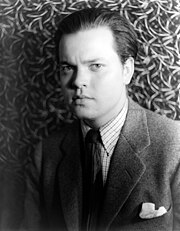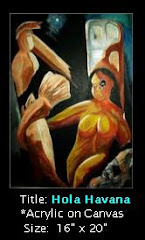Among Halloween radio broadcasts, there is none more famous than the Mercury Theatre's War of the Worlds, broadcast on Oct 30st, 1938.
My parents were listening that Sunday night, and having tuned in from the beginning, knew this was a dramatic presentation. Anyone who listened to the first 2 minutes of the show heard the introduction by Orson Welles.
Osron Welles
Still, some people apparently tuned in late, only to find that instead of hearing the popular Mercury Theatre, their local CBS station was broadcasting a program of dance music by Ramon Raquello and his orchestra.
Within moments, however, there would be a simulated `news flash', indicating that astronomers had detected explosions of `hydrogen gas' on the planet Mars.
With increasing frequency (far too fast, but hey, it was only an hour show), more news flashes would break into to `music program'. First, with an interview with an `astronomer' named Richard Pearson (quite obviously voiced by Orson Welles), who discounts any concerns over Mars being inhabited.
Within seconds, however, there are reports of seismic activity in New Jersey, and the next 30 minutes are a series of flash news reports covering the landing of a space craft in Grovers Mill, New Jersey, and its subsequent attack on the people there.
Soon New York City is under attack by "five great machines" wading across the Hudson River.
Now, the story goes that more than a million people believed this radio broadcast to be real. I doubt that.
There were disclaimers during the shows intermission, a full disclamer in the first two minutes, and quite frankly it has the `sound and feel' of a radio drama.
Anyone alarmed by this broadcast would certainly have checked other stations to see if they, too, were carrying the`news'. The Edgar Bergan-Charlie McCarthy Show was broadcasting on the other network as normal.
The next day, there was a great to-do make over the broadcast, and recriminations against Welles and his radio troop.
New York Times headline from October 31, 1938
The wikipedia describes the reaction thusly:
Professor Richard J. Hand cites studies by unnamed historians who "calculate[d] that some six million heard the CBS broadcast; 1.7 million believed it to be true, and 1.2 million were 'genuinely frightened'".
While Welles and company were heard by a comparatively small audience (in the same period, NBC's audience was an estimated 30 million), the uproar was anything but minute: within a month, there were 12,500 newspaper articles about the broadcast or its impact, while Adolf Hitler cited the panic, as Hand writes, as "evidence of the decadence and corrupt condition of democracy."
Later studies suggested this "panic" was less widespread than newspapers suggested. During this period, many newspapers were concerned that radio, a new medium, would make them defunct. In addition, this was a time of yellow journalism, where newspapers were not held to the same standards as today.
As a result, journalists took this opportunity to demonstrate the dangers of broadcast by embellishing the story, and the panic that ensued, greatly.
While the `panic' caused by this show was probably exaggerated, some people did apparently take it to be real. In any event, legend or fact, it is a piece of history now.
Listen to the most famous Halloween radio broadcast of them all.
And from the same performing troupe, we have another classic of horror presented just 3 months before the War of the Worlds broadcast. This is the first radio broadcast of the Mercury Theatre.








No comments:
Post a Comment